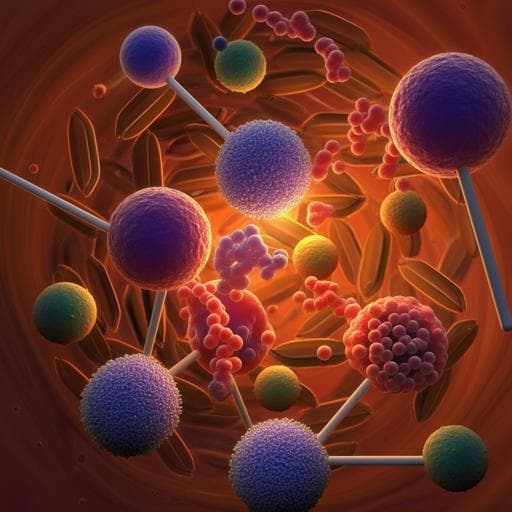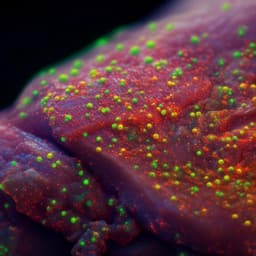
Food Science and Technology
Food nanoparticles from rice vinegar: isolation, characterization, and antioxidant activities
Z. Yu, Y. Tan, et al.
Explore the potential of food nanoparticles from Chinese rice vinegar, isolated and characterized by a team of experts including Zhaoshuo Yu and Ying Tan. These nanoparticles exhibit remarkable antioxidant activities, offering promising applications in nutraceutical and pharmaceutical fields.
~3 min • Beginner • English
Introduction
Self-assembled micro/nano-particles (MNPs) are increasingly recognized in foods and traditional Chinese medicines. These structures, formed during processing via chemical reactions (e.g., Maillard reaction) and physical interactions, can function as bioactive units with diverse biological activities. In acidic foods such as vinegar, abundant nanoparticles (NPs) form during the lengthy fermentation and aging processes, which generate Maillard reaction products (MRPs) and aggregates. Aged Chinese rice vinegar is valued for health benefits (e.g., hypolipidemic, anti-obesity, and microbiome modulation), often attributed to antioxidants including polyphenols and MRPs. However, how vinegar polyphenols interact with the human body and the role of micro/nanostructures remain unclear. Industrial practices often remove precipitates to stabilize liquid foods, potentially eliminating beneficial micro/nanostructures. This study aims to isolate and characterize vinegar micro/nanostructures and evaluate their antioxidant and cellular activities, using gel-chromatography coupled with dynamic light scattering (DLS), followed by compositional analysis, antioxidant assays, and cytotoxicity testing.
Literature Review
Prior studies have identified MNPs in various foods and decoctions, including chicken soup, coffee, tea, and herbal preparations, with reported interactions with immune cells such as macrophages. Fabricated food-grade nanoparticles have been explored for controlled release and bioavailability enhancement, though safety and cost limit applications. In acidic matrices, fluorescent nanoparticles and Maillard-derived micro/nanoparticles have been reported in vinegar and soy sauce. Traditional Chinese rice vinegar contains diverse organic acids and phenolic compounds (notably catechins), and MRPs formed during prolonged fermentation and aging. Previous extraction approaches (e.g., ethanol) may disrupt native NPs, leading to low yields. These works motivate a gentle, chromatographic-DLS approach to isolate and study native vinegar NPs and their bioactivities.
Methodology
Materials: Commercial Chinese rice vinegar (Jiangsu Hengshun Vinegar-Industry Co., Ltd.) was used. Reagents included Blue Dextran (~500 kDa), Bromophenol blue (~670 Da), AAPH, MTT, DCFH-DA, ABTS kit, DMEM, FBS, antibiotics, and buffers. Deionized water (Milli-Q) served as mobile phase after preliminary buffer impact testing.
Isolation by gel-chromatography coupled with DLS: Vinegar was centrifuged at 5000 × g for 15 min to remove precipitates. The supernatant was injected (1 mL) into a Sepharose CL-4B column (1.0 cm × 13.0 cm) on a BIO-RAD UPLC at 0.5 mL/min with deionized water, monitored by UV at 280 and 420 nm and on-line DLS (Zetasizer Nano-ZS) with a flow cell. Fractions were collected (2 mL/tube) using an automatic fraction collector. Three fractions were defined by elution time: P1 (15–27 min), P2 (34–50 min), P3 (50–54 min). Fractions were lyophilized and stored at −30 °C.
Colloidal properties and morphology: Hydrodynamic diameter (Z-average), polydispersity index (PDI), ζ-potential, and particle number/size distribution were measured by DLS (Zetasizer Nano-ZS) and Nanosight LM10 at 25 °C (viscosity 0.8872, refractive index 1.330). Morphology was observed by TEM (JEOL JEM-1230) at 80 kV after staining with phosphotungstic acid on 230 mesh copper grids.
Fluorescence imaging: Fractions were imaged on a FluorVivo fluorescence stereomicroscope under daylight and blue excitation (410–440 nm); images were pseudo-colored by intensity.
Major composition analysis: Protein was quantified by Coomassie Brilliant Blue assay at 595 nm. Carbohydrates were quantified by anthrone-sulfuric acid assay at 590 nm. Total acid and total ester contents were determined by titration (AOAC, 1984) using 0.1 mol/L NaOH and back-titration with 0.1 mol/L H2SO4 for esters. Mineral elements were quantified by ICP-MS after microwave digestion with H2O2 and HNO3; calibration was via multi-element standards.
Bioactive compounds: Total phenols were determined by Folin–Ciocalteu (gallic acid standard, 765 nm). Total flavonoids were measured by AlCl3 colorimetry (rutin standard, 510 nm); samples were neutralized with 2% NaOH prior to assay.
FT-IR spectroscopy: FT-IR spectra (Shimadzu FT-IR-8400) were recorded with 32 scans and 1 cm−1 resolution.
Antioxidant assays: Extracellular ABTS radical cation decolorization was performed per kit instructions, reported as Trolox equivalents (TE) mmol/g dry sample. ORAC assay recorded fluorescence (Ex 485 nm/Em 520 nm) every 2 min for 120 min and expressed as TE mmol/g.
Peritoneal macrophage preparation: Murine peritoneal macrophages were obtained from SD mice by peritoneal lavage with DMEM, washed, and cultured (5 × 10^4 cells/well) at 37 °C, 5% CO2. Animal procedures were approved (Zhejiang Academy of Medical Sciences, No. 2019R07001).
Cellular antioxidant activity (CAA): Macrophages (1×10^5 cells/well) were incubated with samples and DCFH-DA (50 µM) for 1 h, washed, and challenged with AAPH (600 µM). Real-time fluorescence (Ex 485 nm/Em 538 nm) was monitored every 5 min for 1 h. CAA unit = (1 − AUCsample/AUCcontrol) × 100%.
Cytotoxicity: MTT assay was performed after 24 h exposure to P1 or P2 (25–400 µg/mL). MTT (0.5 mg/mL) incubation for 4 h, followed by DMSO solubilization and absorbance at 570 nm. Dose equivalence to vinegar volume was noted (400 µg P1 ≈ 90 µL vinegar; 400 µg P2 ≈ 2.2 µL vinegar). Each test in triplicate.
Statistics: Data are mean ± SD (n = 3). Significance assessed by t-test (p < 0.05).
Key Findings
- Fractionation and size/charge: Three fractions were isolated: P1 (15–27 min), P2 (34–50 min), P3 (50–54 min). DLS Z-average sizes: P1 210.4 ± 3.0 nm; P2 245.4 ± 6.1 nm; P3 1643.0 ± 73.4 nm; vinegar overall 486.7 ± 2.0 nm. PDI: P1 0.30 ± 0.03; P2 0.44 ± 0.02; P3 0.44 ± 0.13; vinegar 0.38 ± 0.02. ζ-potential: P1 −32.20 ± 0.65 mV; P2 −1.37 ± 0.78 mV; P3 −0.76 ± 0.02 mV; vinegar −3.40 ± 0.54 mV. Particle concentrations (10^9/mL fraction): P1 14.60 ± 0.42; P2 2.97 ± 0.63; P3 0.86 ± 0.10; vinegar 142.80 ± 2.07.
- Morphology: TEM showed spherical nanoparticles in P1, lollipop-like nanoparticles in P2, and spherical microparticles in P3.
- Composition (wt% unless noted): P1 rich in protein (53.1 ± 0.7%) and carbohydrates (31.9 ± 1.1%); negligible total acids and low esters (2.6 ± 0.6%) and minerals (2.6 ± 0.4%). P2: carbohydrates 37.0 ± 0.4%, total acids 39.1 ± 1.4%, esters 12.3 ± 1.7%, minerals 9.1 ± 0.1%, protein 1.5 ± 0.1%. P3: carbohydrates 36.6 ± 0.9%, total acids 14.0 ± 0.8%, esters 20.3 ± 1.3%, minerals 23.8 ± 1.1%, protein 0%. Mass per mL vinegar: P1 4.5 ± 0.1 mg; P2 185.0 ± 4.3 mg; P3 2.0 ± 0.2 mg.
- Minerals (mg/L): Total minerals concentrated in P2 (16884.25 ± 145.99 mg/L) >> P3 (594.31 ± 2.87) >> P1 (117.88 ± 1.95). Dominant ions: Na and K, followed by Mg, Ca, Fe; P1 contained minimal minerals.
- Polyphenols/flavonoids and loading: P1 total phenols 8.67 ± 0.80% and total flavonoids 6.82 ± 0.56% (≈15.5% combined). P2 total phenols 1.17 ± 0.08% and flavonoids 0.87 ± 0.02% (≈2.0% combined). Polyphenols appear bound within NPs, co-eluting with P1 during size-exclusion separation.
- FT-IR: Both P1 and P2 showed O–H (~3414 cm−1), C–H (~2930 cm−1), amide I/II/III (1650/1540/1400 cm−1), carbohydrate-associated bands (1047–1037 cm−1), and aromatic C–H bending (~671 cm−1). P2 exhibited a ~1620 cm−1 −COOH band consistent with high organic acids; P1 lacked carboxylic acids.
- Antioxidant capacity (extracellular): ABTS (mmol TE/g): P1 0.83 ± 0.11; P2 0.29 ± 0.07. ORAC (mmol TE/g): P1 1.19 ± 0.07; P2 0.16 ± 0.03. P1 outperformed P2, consistent with higher polyphenol content.
- Cellular antioxidant activity (CAA): Both P1 and P2 reduced AAPH-induced intracellular ROS in murine peritoneal macrophages, with dose-dependent effects and CAA > 60 units at 200 µg/mL; P1 slightly higher than P2.
- Cytotoxicity: P1 showed no cytotoxicity up to 400 µg/mL and enhanced proliferation by ~35% at 25 µg/mL. P2 was non-toxic at 25–200 µg/mL but reduced viability by >30% at 400 µg/mL, likely due to high organic acids.
- Fluorescence: Strong fluorescence mainly in P2, suggesting presence of fluorescent MRPs/carbon nanodots (<20 nm) that may aggregate into NPs.
- Stability/precipitation: P1’s more negative ζ-potential suggests better colloidal stability upon dilution (larger Debye length). Mineral-rich P2 and P3 tended to aggregate and may act as precipitate precursors. P3 size was unstable (online DLS <20 nm vs. static DLS >1 µm), and was not further examined.
Discussion
The study demonstrates that native nanoparticles in aged Chinese rice vinegar are discrete colloidal entities with distinct compositions and bioactivities. P1 nanoparticles, composed primarily of proteins and carbohydrates and carrying a high polyphenol load (~15.5%), exhibit strong radical-scavenging capacity (ABTS and ORAC) and cellular antioxidant activity, and promote macrophage proliferation without cytotoxicity. This supports the hypothesis that micro/nanostructures serve as functional bioactive units in foods and can enhance the stability, concentration, and potential bioavailability of small-molecule antioxidants via binding and co-assembly with biopolymers and MRPs. P2 nanoparticles, while lower in polyphenols, concentrate flavor-related organic acids, esters, minerals, and fluorescent MRPs, still providing notable cellular antioxidant effects, possibly via differences in uptake and surface charge despite lower initial phenolic content. ζ-potential differences explain elution behavior and colloidal stability; the more negative P1 repels the chromatographic matrix, eluting earlier and maintaining dispersion upon dilution, whereas mineral-rich P2/P3 tend to aggregate and may form precipitates in vinegar. Collectively, these findings clarify how vinegar NPs can mediate antioxidant and potential immunomodulatory effects through macrophage interactions and suggest that removing such particles (e.g., during clarification) could diminish vinegar’s functional properties.
Conclusion
Using gel-chromatography coupled with DLS, the study isolated and characterized three vinegar-derived particulate fractions: protein–carbohydrate spherical nanoparticles (P1), lollipop-like nanoparticles enriched in organic acids/esters/minerals (P2), and low-abundance microparticles (P3). P1 nanoparticles acted as high-capacity carriers for polyphenols, delivering strong extracellular and cellular antioxidant activities and supporting macrophage viability. P2 contributed to antioxidant activity and concentrated key vinegar constituents, though with cytotoxicity at very high doses. The work positions food-derived nanoparticles as intrinsic functional units and promising, safe nano-carriers for nutraceuticals and pharmaceuticals. Future research should investigate in vivo fate, biodistribution, and bioavailability of vinegar NPs within the gastrointestinal tract, interactions with mucosal fluids and microbiota, identification of active principles driving macrophage proliferation, stabilization strategies to prevent beneficial payload loss via precipitation, and broader applicability to other liquid foods (tea, coffee, juices).
Limitations
- The P3 fraction was low in abundance and exhibited unstable size behavior (online DLS <20 nm; static DLS >1 µm); it was not further characterized.
- Antioxidant and cytotoxicity assessments were conducted in vitro using murine peritoneal macrophages; in vivo relevance, gastrointestinal stability, and pharmacokinetics remain to be established.
- The complex mixture nature of fractions limits precise attribution of bioactivities to specific components (e.g., particular polyphenols or MRPs).
- Buffer and ionic strength effects on colloidal stability indicate that matrix conditions can alter particle properties; stability under physiological conditions requires further study.
- The method quantifies total phenols/flavonoids but not individual compounds or binding modes (covalent vs non-covalent) within NPs.
Related Publications
Explore these studies to deepen your understanding of the subject.







